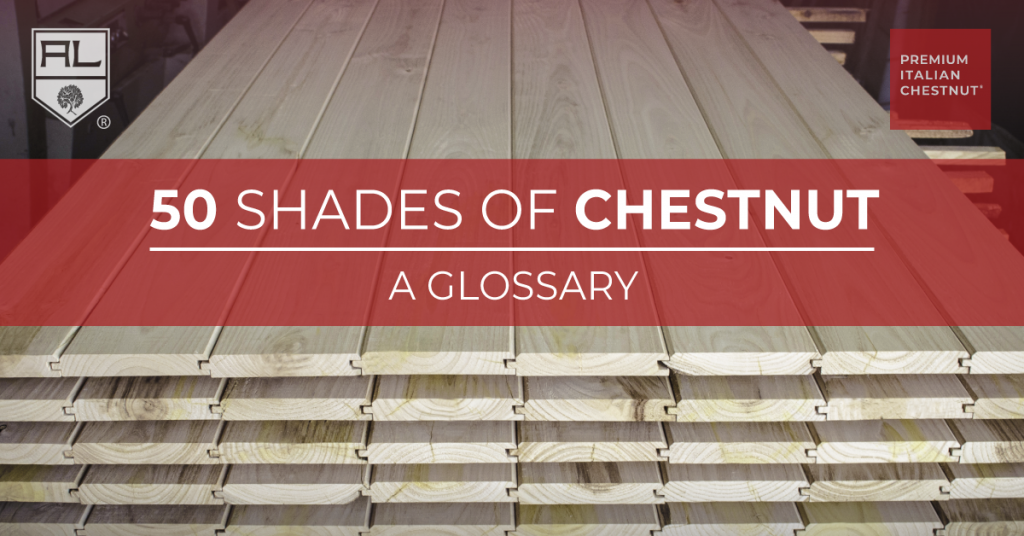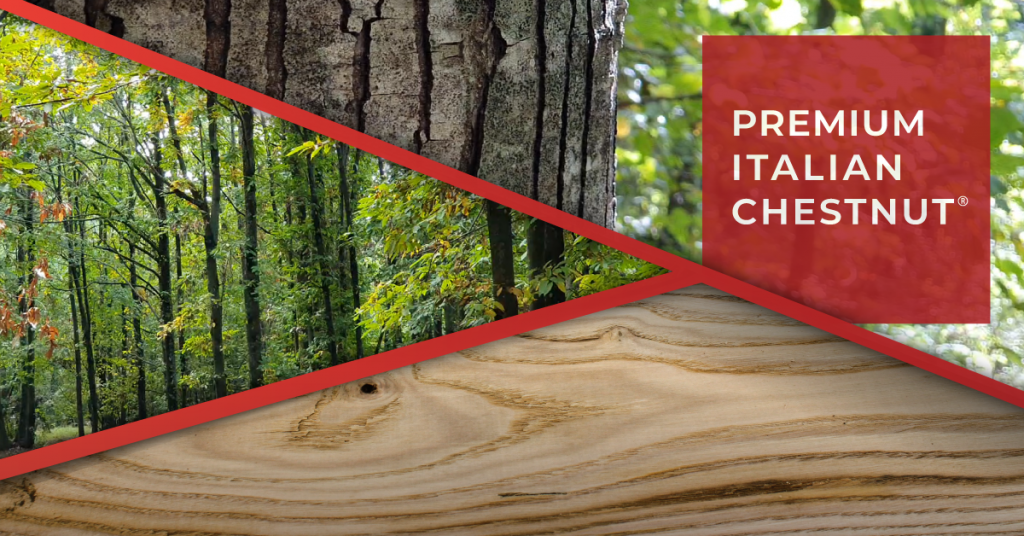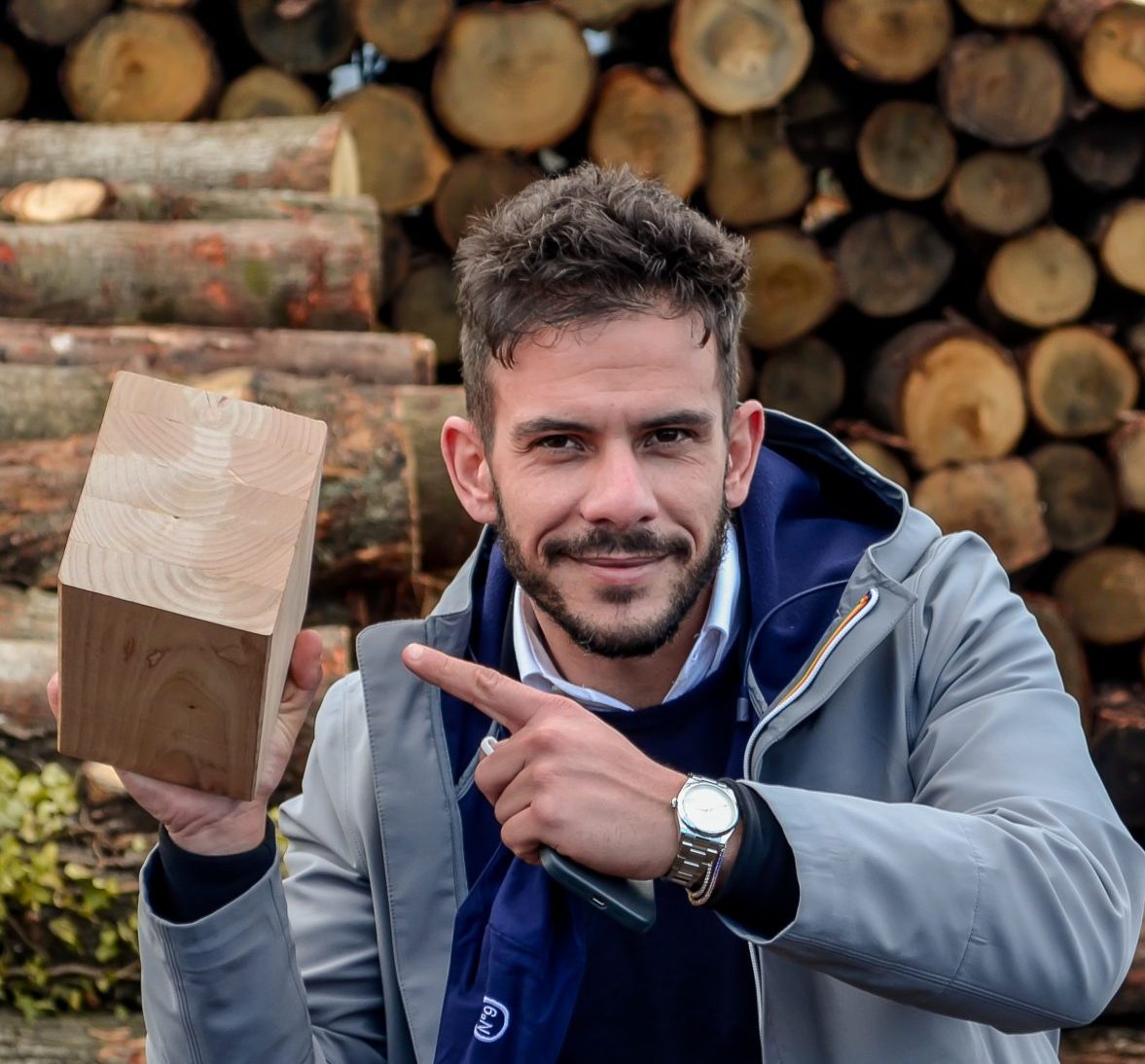
A PROTAGONIST, A GLOSSARY
He is tall, long-lived and elegant. No, we don’t want to talk about some umpteenth James Bond or other Hollywood stars, but our favorite character: the Chestnut.
Just like the movies, the world of wood has a lot to reveal about one of its main protagonists. Nothing transcendental, of course, but rather technical and qualitative: the Chestnut is really worth analyzing and going through its peculiarities, starting from its founding element, wood, until composing a sort of well-defined identity card. A complete file with every feature, property, function and edge.
There are 50 shades of Chestnut, fundamental elements of a story to be told.
Lights, Camera… Action!
The difference between Wood and Timber
Wood: is the plant tissue generally indicating the roots, stem and branches of trees. Chestnut wood: light brown in color – obvious grain.
Timber: the term timber is generally used to indicate the set of wood product which are classified according to strength and delivered by specific producers for various applications (e.g. carpentry, construction).
Anatomy of wood: Sections, micro and macro Structures
Wood can be defined and characterized through three anatomical sections: cross section, radial section and tangential section.
Cross section: or perpendicular to the axis of the tree (through which the age of the tree can be estimated).
Radial section: that which passes through the axis of the plant (represents the strongest part of the trunk).
Tangential section: perpendicular to the radial section (the tangential section appears frequently in sawn wood, where it is possible to observe the grain).
Annular porosity: vascular elements (or pores), seen in cross section, appear comparatively large in cell at the beginning of the formation of each growth ring and then decrease in size giving rise to a distinct porous circle, known as the “early wood” zone, and an outermost zone of reduced pores, known as “late wood.”
Sapwood: the active peripheral portion (containing living cells and conducts sap) of the wood of a standing tree that is often distinguished from the central heartwood portion by its lighter color. It can easily attacked by biodegradation agents due to its abundant sugar-like reserve substances. Sapwood is generally removed during processing.
Pith: small portion, generally a cylindrical shape, often present at the center of the cross-section of a stem formed during the early stages of the tree’s growth, corresponding to the position in which the vegetative apex is gradually found.
Heartwood: the inactive central portion of the wood of a standing tree that extends between the pith and sapwood from which it is distinguished by its generally darker color (in species with differentiated heartwood) and greater natural durability due to the frequent presence of phenolic compounds, gums, resins and other substances with antiseptic properties.
Tannin: extracted from wood or bark which has phenolic radicals. Very abundant in some tropical woods, in the past it was used for tanning hides.
Texture: morphological wood property. It’s determined by its anatomical structure and the width and uniformity of the growth rings. It is usually defined by the adjectives “coarse”, “semi-fine” or “fine”.
Basal shoot (Pollone): a wood (non-fruit-bearing) branch that originates at the base of the tree’s stem; it is a type of branch that should always be cut off through specific operations, in order to avoid deformities and several morphological anomalies.
Forest: (tall forest) forest in which plants (broadleaf and/or coniferous) born from seed are prevalent.
Coppice: (coppice forest) a forest stand of broadleaf trees that is reconstituted by vegetative propagation after each periodic cut through the emission (regrowth) of suckers from a stump, i.e. stems of limited diameter from which are obtained mostly assortments for the production of poles and wood fuels.
Governance: (form of) mode of forest renewal. Typically, “coppice” and “high forest” government are recognized.
Strength class: a performance profile for the structural use of wood, based on specific values of mechanical and density properties, resulting from a classification process.
Veining: visible figure on the surface of a semi-finished product, formed by the traces of the periodic growth of the wood.
Density: the ratio between the mass of wood or a semi-finished product and its volume measured generally under the same conditions of humidity. The density is expressed in kg/m3.
Natural durability: in general terms, it indicates the ability of an untreated wood or wood product to resist degradation induced by environmental (physical-chemical) and biological stresses (caused by bacteria, fungi, insects and marine organisms). Specifically, indicates the intrinsic resistance of the wood to the attacks of lignivorous organisms both for the portion of sapwood and heartwood and in relation to the conditions of use.
Hygroscopy, Seasoning and Drying processes
Hygroscopicity: It’s the ability of a substance, or materials, to absorb water molecules present in the surrounding environment. Wood is a hygroscopic material, i.e. a natural regulator of humidity.
Seasoning: the process of working with wood, which contains a significant amount of water (the wet weight can reach up to ¾ of the weight of the wood). Once the wood has been cut and transformed into boards, it gradually “loses” this moisture, until it becomes balanced with the surrounding environment. Before this happens it is practically impossible to use wood as a working material.
Drying process: it is included in the maturing process. It is the direct consequence of two phenomena: 1) circulation and balance of the amount of water, 2) evaporation of water influenced by environmental factors. Immediately after the first cut, the boards are piled up in an open-air place away from bad weather: it is an operation that takes time and requires specific operations (e.g. storage, ground, arrangement of piles) unless a specialized furnace is used to heavily reduce the time of drying, guaranteeing a high quality timber.
Critical factors and Diseases of Chestnut trees
Ring shake: discontinuity between contiguous growth rings that extends tangentially along the axis of the stem and affects some provenances. It can be limited at the origin with good silviculture; some assortments are less penalized such as those for naturalistic engineering projects.
Surface stains: dark-colored variations that originate at contact points between wood and metals, in the presence of moisture, due to chemical reactions with tannins. Through good design of these contact areas, stains can be removed with oxalic acid solutions.
Cortical cancer: it is a necrotic disease that affects the woody organs of the Chestnut tree, caused by the fungus Cryphonectria parasitica. Symptoms: in the initial stages, the bark takes on a reddish color and a depressed appearance; later on, the tree tries to react through the cicatrization of the destroyed tissues, which gives rise to the so-called cortical necrosis (defined precisely as cancers). European chestnut trees, unlike those in the United States, have suffered a minor negative impact.
Ink illness: it is a disease that affects trees. It is caused by the fungi Phytophthora cinnamomi and Phytophthora cambivora: while the latter “keeps” the attack exclusively to the Chestnut tree, the cinnamomi species turns out to be insidious for more than 900 types of plants belonging to more than 200 genera. The disease appears frequent in places characterized by a high degree of humidity, causing consequently a yellowing of the leaves and a decrease of the flowering; the recommended treatment consists in the net cut of the interested tree and in the mechanical or chemical elimination of the stump.

Wood as an expression of Sustainable Development
Hectare: unit of measurement equal to 10000 square meters used in the agro-forestry sector to indicate the area of land devoted to different forms of cultivation.
Silviculture: it is part of the macrocosm of forestry sciences and deals directly with those activities that allow the planting, cultivation and use of forests, ensuring over time their safe renewability in purely sustainable terms.
Green building: also called sustainable/bio-ecological architecture or engineering, is a methodology of design, construction and renovation of buildings devoted to a low environmental impact and ecological procedures, integrated with both innovative technologies and the use of natural materials.
The properties of Solid wood, Hard wood and Laminated wood
Solid wood: solid wood is obtained from a part of the trunk, the heartwood, the central dark portion that extends between the pith and the sapwood. This type of wood guarantees a higher quality product, being counted among the best selections especially in the field of green building and indoor and outdoor furniture.
Hard wood: Solid wood is characterized by the coexistence of heartwood and sapwood, highlighted by the lack of color homogeneity in the final product. Hard wood is a lower quality element respect to solid wood, but still ensures a good level of production.
Lamellar: natural wood made on industrial scale. It is positioned on the lowest step of the value podium. It has two defects: dimensional instability (possible insinuation of moisture between wood and charred layer with consequent cracking on the surface) and biological perishability (subject to fungi and mold).
Assortment: generic term used to indicate a piece of solid wood (for example, a log or stump) or a semi-finished product characterized by specific dimensional and qualitative requirements established in relation to a specific use. In this regard, we also speak of “sawing log”, “veneer log”, etc..
Wood in Construction: a wide range of Choices
Primary warping: formed by beams placed on the ridge and eaves line (ground force discharge).
Secondary warping: composed of rafters (or joists) where all the various layers of the roof rest.
Chestnut beam: part of the primary framework of roofs and floors. It goes from standard sections 15×15 cm up to 42×42 cm with lengths that can reach 12 mt. Available for “Uso Fiume” and ”Sharp Edge” use: specific processing can be carried out on the ends of beams and morals to increase the aesthetic value.
Uso Fiume beam: it is extracted from the bark and has the same qualities as the classic one. Its main characteristic is the “blunt edge” that is regulated by European classification rules (CE marking included) and it also gives an additional aesthetic value to the final product.
Sharp Edge Beam: it is a traditional beam, with a square and angular appearance.
Chestnut rail: it is used in the secondary warping of the roof and it is indispensable in the support of the planking or terracotta tiles. It is produced with standard sections ranging from 8×8 to 12×12 and with lengths from 100 to 800 cm.
Board: a seasoned board is generally used in the construction of attics, floors and coatings. The thickness of chestnut planks varies from 2 to 4 cm, with lengths that can reach up to 200 cm.
Matchboard: planed wooden board with joints on the sides called “male” and “female” (with the possibility of customization), used for the coating of walls and ceilings.
Sliced wood: consists of extremely thin sheets resulting from the shearing of solid wood boards. There are several classifications of veneer: broad, Italian, French, Swedish.
Veneer: thin semi-finished wood product, less than 7 mm thick. The term is little used in technical language in Italy, where it is preferred to specify the method of processing by which the sheet has been obtained and is therefore more commonly referred to as “sliced” or “peeled”.
Truss: an architectural element formed by a flat, vertically placed truss, used as the basic component of a pitched roof. Thanks to the triangular structure, the truss cancels the horizontal thrusts allowing to obtain stability and safety. Artena Legnami is able to realize trusses of any kind thanks to highly specialized workers; this operation is also possible thanks to the certificate issued by the Central Technical Service and the Superior Council of Public Works for the processing and transformation of structural elements in solid wood and laminated wood.
Chestnut pole: from the classic use for fences to complex works of naturalistic engineering, chestnut poles can be used in a variety of ways. The intrinsic qualities of chestnut guarantee a resistant and durable product, particularly suitable for vineyards and anti-hail systems.
Parquet: element intended for the construction of a wooden floor; it must have the thickness of the top layer not less than 2.5 mm before installation.
Pellets: fuel obtained from pulverized and compressed biomass, with or without the use of binders, having a cylindrical shape and length included between 5 and 30 mm. The raw material used for the production of pellets can be woody biomass, herbaceous biomass, fruit biomass or a mixture of different types of plant residues.
The importance of Certifications
CE Marking: “Certificate of Conformity of Factory Production Control”, designates a set of practices mandatory for all products for which there is a Community directive, which also includes the application of a symbol with the letters “CE” on the product subject to marking (hence the name).
PEFC certification: an acronym for Programme for Endorsement of Forest Certification schemes. PEFC is a worldwide non-governmental organization founded in 1999 which, through the support of forest owners, public administrations, environmental/wood marketing organizations, trade associations and workers’ unions, deals with the sustainable management of forests, safeguarding and protecting the environmental heritage for future generations. PEFC Chain of Custody certification provides an independently verified guarantee that the certified material – of wood and tree origin – contained in a product comes from sustainably managed forests; it complements PEFC Sustainable Forest Management certification, which ensures that forests are managed in line with stringent environmental, social and economic requirements.
The Top Quality of our Chestnut
Premium Italian Chestnut®: a customer brand loyal to the Chestnut tree, a well-known plant that grows in one third of the national territory. It is identified as an isolated tree and as a species characterizing some types of woods located in a phytoclimatic area that takes its name (Castanetum). But why the Chestnut tree? Because, in addition to unique properties and characteristics – long life, lightness, resistance, sustainability and versatility in the building world – it represents our pride, in terms of selection and prestige: a true heritage of the Italian wood industry, a guarantee of absolute quality for our customers.
Click HERE to learn more about the structural use of our Premium Italian Chestnut®. Also, follow us on our Facebook and Instagram pages for news and insights on the Chestnut Culture.
Don’t miss our other publications:
THE 5 PILLARS OF SUSTAINABILITY – PEFC
CE MARKING CHESTNUT TIMBER
7 REASONS TO CHOOSE SOLID CHESTNUT
THE ECONOMY OF CHESTNUT
THE POWER OF TANNIN
A CHESTNUT RECORD
BACK TO THE WOOD



